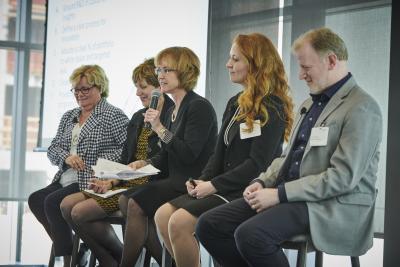How Can Fortune 500 Companies Solve Problems Faster?

What are the greatest barriers to medtech innovation? And what are the most impactful ways to empower Fortune 500 teams to overcome them?
These were among the questions addressed at the inaugural MedExecWomen conference in New York City this week, leading executives from across the medtech industry gathered to share insights and inspiration.
Mary Beth Moynihan, senior vice president of Corporate Marketing and Market Access at Boston Scientific, led a discussion on how to innovate in a Fortune 500 medtech company that uncovered some surprising—and occasionally contradictory—takeaways from the panel and from the executives in attendance.
In a poll of attendees, it became clear that barriers to innovation were varied. Thirty percent of attendees agreed that pressure to stick to the corporate comfort zone and focus on core businesses was the greatest challenge, followed closely by limitations posed by homogenous teams (nearly 27 percent) and teams that aren’t sufficiently empowered to make decisions (25 percent).
Consensus on how best to overcome these barriers was equally elusive:
- Nearly half of attendees (40 percent) agreed that the most impactful solution to unleash innovation is to provide employees with time, resources and programs.
- One-third of respondents (32.7 percent), however, focused on the importance of creating a risk-taking culture.
- Roughly one-quarter of respondents (23.6 percent) focused on the voice of the customer, and the importance of grounding research and development in customer insights as the clearest path forward.
“In reality, there’s no single path to meaningful innovation,” said Moynihan. “But to generate solutions that can change the healthcare system and truly improve patients’ lives, we have to ground ourselves in our patients’ journeys and our customers’ perspectives, and empower our teams to act.”
How to do it? These observations from the leading medtech executives on her panel shed some light:
Eliminating waste to fuel breakthroughs: Tracy MacNeal, President, Diagnostics and Digital Health, Ximedica
“While we all want to be slow enough to be safe, no one is interested in bureaucracy and unnecessary loops. I think it’s great to bring teams through LEAN processes, looking at where we can free up a team’s life force energy by eliminating waste. From there, we can take time to celebrate both the ideas that will move forward and learnings from projects that aren’t going to work.”
Beginning with the end in mind: David Knapp, Vice President, Corporate Research, Boston Scientific
“It’s critical to identify the right landing pad. For our front-end work in Corporate Research, we balance between consciously not innovating in the core business, where there’s already a lot of development within the organization, but not operating so far into the white space that a concept can’t land. Our happy medium—and arguably the key to intrapreneurship in a large company—is in these high-growth adjacencies.”
Grounding innovation in insight: Tracy Accardi, Global VP, Research & Development, Hologic
“You have to ensure that market insights are real, so that the team trying to innovate has real customers, patients and doctors to speak to. Our process involves marketing and R&D to define the unmet need and how we might begin to describe a solution, but it’s grounded in detailed feedback on different approaches before we actually go after the problem.”
Cultivating a healthy appetite for risk: Helen Routh, Board Chair, Ultromics (former SVP Strategy & Innovation, Head of Integrated Solutions, Philips)
“We have to support innovation at the individual level—like fellow sabbaticals to learn areas outside of their current experience. From there, innovating in both technology and business models is essential to ensure that new solutions get to market. Risk appetite can be addressed by re-use through both technology and business model ‘platforms.’ And if your product teams agree with everything in your portfolio, you’re probably not taking enough risk!”